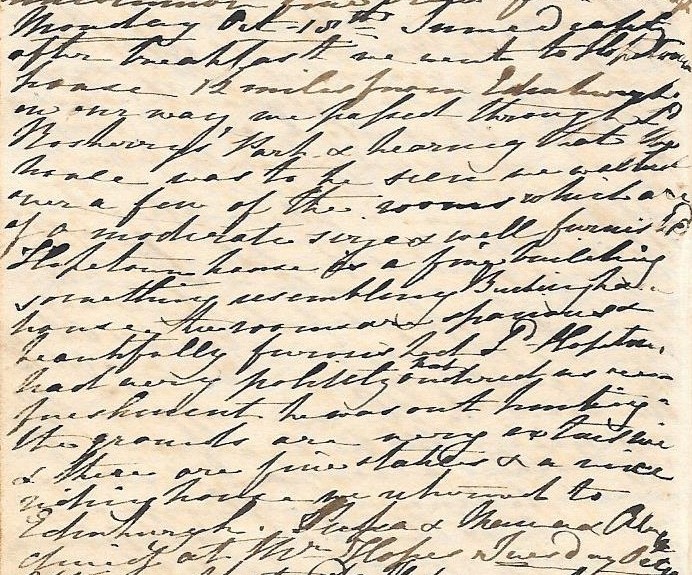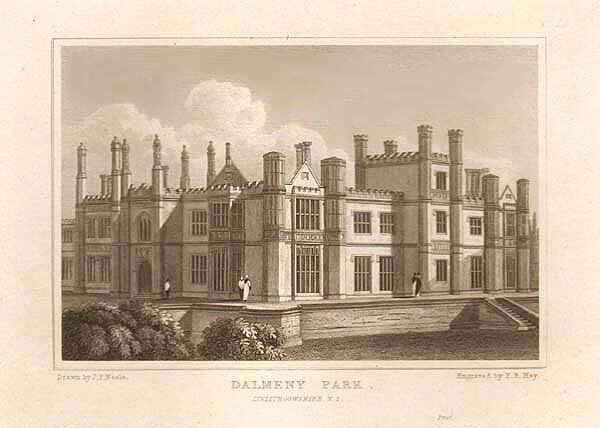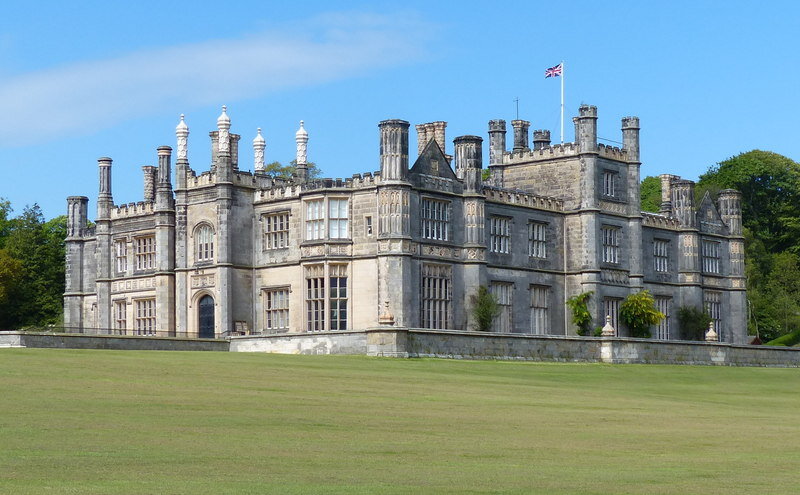Monday 18th October 1819
Monday Oct 18th immediately after breakfast we went to Hopetoun House 12 miles from Edinburgh in our way we passed through Ld Rosberry’s Park & hearing that the house was to be seen we walked over a few of the rooms which are of a moderate size & well furnished Hopetoun House is a fine building something resembling Buckingham House the rooms are spacious & beautifully furnished Ld Hopetoun had very politely ordered us refreshment he was out hunting the grounds are very extensive & there are fine stables & a nice riding house we returned to Edinburgh. Papa & Mama & Alexander dined at Mr Hopes.
OBSERVATIONS & COMMENTS:
Hopetoun House was built 1699-1701 and designed by Sir William Bruce. It was then hugely extended from 1721 by William Adam until his death in 1748, being one of his most notable projects. The interior was completed by his sons John Adam and Robert Adam. The magnificent entrance hall dates from 1752.
1871: Hopetoun House, Visited by the British Association, from the Illustrated London News'of August 19 1871. https://www.ebay.co.uk/itm/233346762119
2016: Hopetoun House. Author Godot13 , Copyright holder Andrew Shiva / Wikipedia. Published under the (CC BY-SA 4.0) Creative Commons Attribution-Share Alike 4.0 International license. https://commons.wikimedia.org/wiki/File:Scotland-2016-West_Lothian-Hopetoun_House_01.jpg
The Hope family acquired the land in the 17th century and operated lead mines. Charles Hope, the first occupant, was only 16 years old when his mother, Lady Margaret Hope, signed the contract for building with William Bruce, on 28 September 1698. The master mason is noted as Tobias Bachope of Alloa. The plumber and glazier was John Forster of Berwick. The house was the site of the departure of the visit of King George IV to Scotland on the 29th August 1822. https://en.wikipedia.org/wiki/Hopetoun_House
2009: View of the rear of Hopetoun House, near Queensferry, Edinburgh by George Gastin, the copyright holder of this work, and published under the Creative Commons CC0 1.0 Universal Public Domain Dedication. https://commons.wikimedia.org/wiki/File:Hopetoun_house_sunny_day.jpg
Dalmeny House was completed in 1817 for Archibald, 4th Earl of Roseberry 1783-1868, and sits in rolling parkland to the West of Edinburgh. With spectacular views overlooking the Firth of Forth. The Earl realised the need to replace the family house, Barnbougle Castle, and shortly after his father's death he commissioned plans for a new house from William Wilkins.
1819: Dalmeny Park. Engraving by F.R. Hay after J.P. Neale. https://antique-prints-maps.com/acatalog/ref1.php?imagefile=../largeimages/SEDalmenyPark.jpg
By 1817 the present Dalmeny House was completed, and Barnbougle Castle, just a quarter of a mile away on the shore, was left to the sea birds. In contrast to the exterior, most of the principal rooms are in the Regency style, with the exception of the hammerbeam roof of the hall.
2016: Dalmeny House is a Tudor Gothic Revival mansion overlooking the Firth of Forth, by Mat Fascione. This image was taken from the Geograph project collection.The copyright on this image is owned by Mat Fascione and is licensed for reuse under the (CC BY-SA 2.0) Creative Commons Attribution-Share Alike 2.0 Generic license. https://commons.wikimedia.org/wiki/File:Dalmeny_House_(geograph_4979104).jpg
Harriet Bouverie, his wife and mother of his four children, never saw her new house. In a notorious divorce case in 1815 Lord Rosebery sued his brother-in-law, Sir Henry Mildmay, for “alienating his wife's affections”. Sir Henry, whose dead wife had been Harriet's sister, had followed her from London and arrived at the castle by rowing boat from Cramond, disguised as a fisherman. The mud from his boots was noticed on the carpet, and he was discovered in Lady Rosebery's bedroom by Lord Rosebery's younger brother Frank. Sir Henry was chased out of the window and Lady Rosebery was sent after him by carriage early next morning. Together they left for the continent, where they eventually married and spent the rest of their lives. https://roseberyestates.co.uk/dalmeny-house
General John Hope, 4th Earl of Hopetoun, was in residence at Hopetoun House in 1819.
John Hope (1765 - 1823), the fourth Earl of Hopetoun, after Sir Henry Raeburn (1756-1823) . Online source. This work is in the public domain in its country of origin and other countries and areas where the copyright term is the author's life plus 70 years or fewer. https://commons.wikimedia.org/wiki/File:John_Hope,_4th_Earl_of_Hopetoun.jpg
He commanded a Division during the advance into Spain and commanded the British left at the Battle of Corunna in 1809, succeeding to overall command when Sir John Moore was killed. Later that year he commanded the reserve army during the Walcheren Campaign. He was appointed Commander-in-Chief, Ireland and was admitted to the Irish Privy Council in 1812. He then commanded the First Division under The Duke of Wellington at the Battle of Nivelle and at the Battle of the Nive in 1813. He was captured fighting the French sortie at the Battle of Bayonne in 1814. He was highly commended by Wellington, who said, " he was the ablest man in the Peninsular army." https://en.wikipedia.org/wiki/John_Hope,_4th_Earl_of_Hopetoun
Hopetoun House Garden park: The English garden style landscape park in which it lies were laid out in 1725 by William Adam. The east front centres on the distant isle of Inchgarvie and North Berwick Law. The walled garden dates from the late 18th century. In the grounds an 18th-century mound was excavated in 1963 to reveal the remains of the earlier manor house, Abercorn Castle, dating from the 15th century. https://en.wikipedia.org/wiki/Hopetoun_House
The house and grounds are open for part of the year. https://hopetoun.co.uk/house-and-grounds/visit-the-house-and-grounds/
Mr Hope Papa & Mama & Alexander dined at Mr Hopes. According to The Peerage General John’s sons were younger than Lucy. His father, the 2nd Earl of Hopetoun had three wives, and John was the son of the second and succeeded to the title when his older brother died in 1817. His younger stepbrothers were General Hon. Charles Hope (1768-1828) who had one daughter, and General Hon. Sir Alexander Hope (1769 - 1837) whose children were younger than Lucy. Both were high ranking officers and Lucy would probably have referred to their military title than “Mr”. Tomorrow after breakfast the family are taken by a “Dr Hope” to some of the most important sites in Edinburgh. Were the titles Mr and Dr interchanged by Lucy, referring to the same person, and could he have been a more distant cousin of General John, the 4th Earl?
Can you help us?
Mr or Dr Hope? Obviously a person of influence connected to the ennobled Hope family, who was he?
Old Regency Prints, Pictures an Coaching maps: Do you have access to any prints or pictures showing what town and country would have looked like when Lucy travelled through? Any illustrations of what she would have seen in 1819 will enliven our research.
New Pictures: Do you have any modern pictures of the streets, buildings, gardens and views that would enable us to see the changes that two centuries have wrought?






